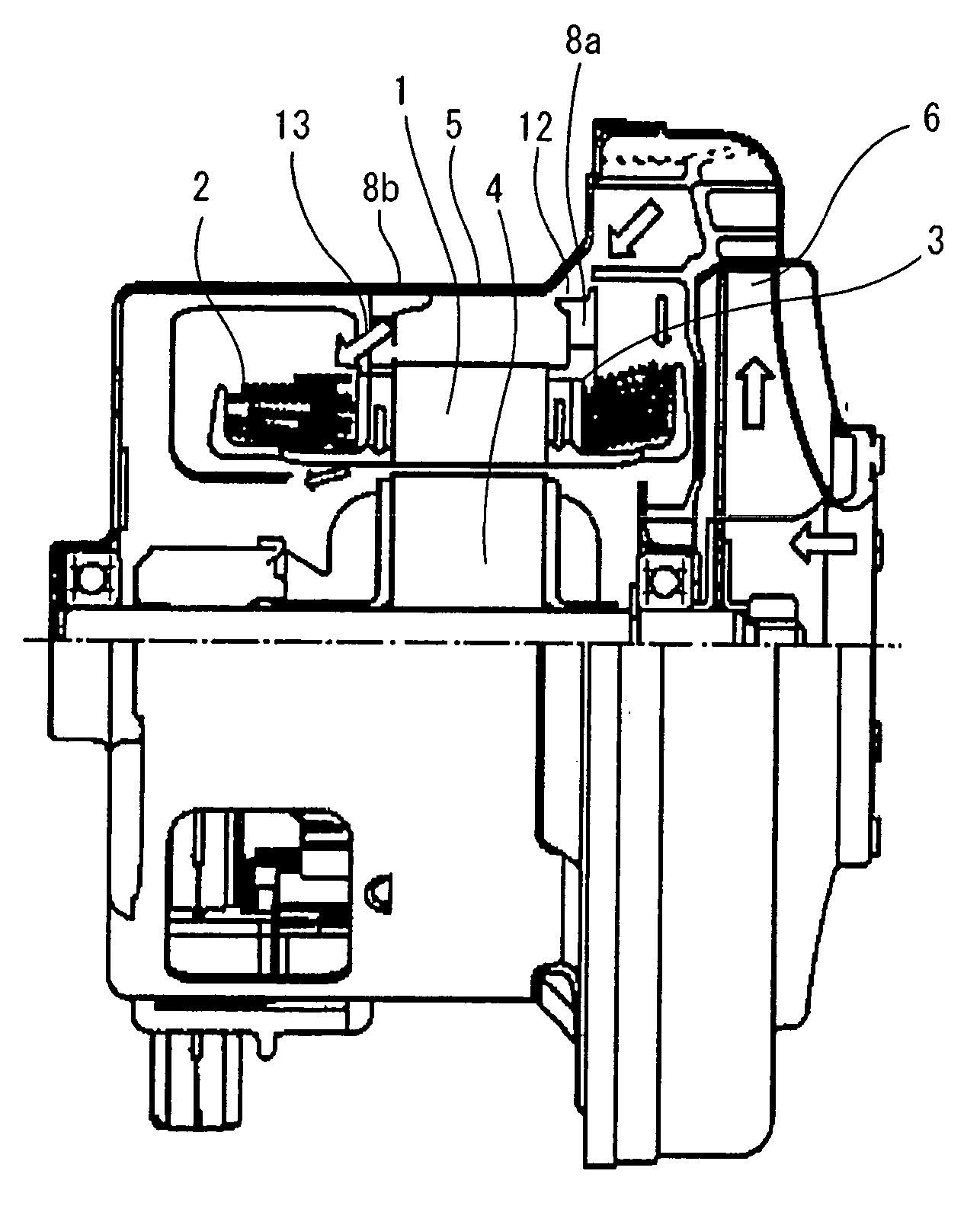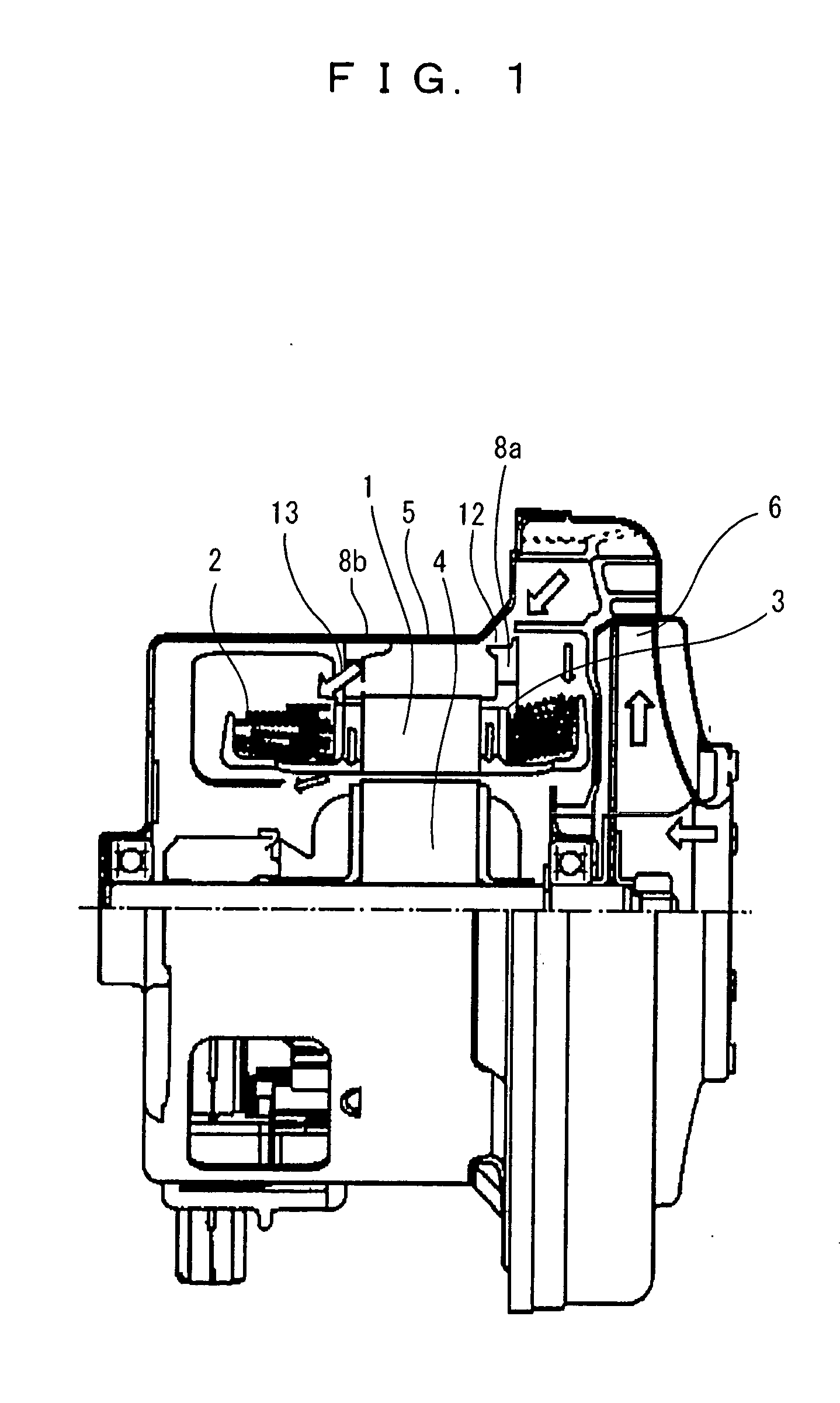Electric blower
a blower and electric technology, applied in the direction of positive displacement liquid engines, piston pumps, liquid fuel engines, etc., can solve the problems of low cooling effect of the wiring, weak cooling effect of the field wiring at large temperature difference between the field wiring at the fan side and the opposite side of the fan, so as to improve the rise of the field wiring temperature and reduce the weight
- Summary
- Abstract
- Description
- Claims
- Application Information
AI Technical Summary
Benefits of technology
Problems solved by technology
Method used
Image
Examples
embodiment 1
[0032]FIG. 1 shows a half cross-sectional view of an electric blower according to one embodiment of the present invention. In FIG. 1, reference numeral 1 denotes a field core, reference numeral 2 denotes a field wiring, reference numeral 3 denotes a spool, reference numeral 4 denotes an armature, reference numeral 5 denotes a motor frame, reference numeral 6 denotes a rotary fan, reference numerals 8a and 8b denote wall surfaces of the spool.
[0033] Here, a flow of air which flows into the motor will be explained. The air discharged from the rotary fan 6 flows inside the motor along the motor frame 5, and is separated into a first flow (thick arrow) which is guided to the field winding 2 by the wall surface 8b of the spool 3 at the opposite side of the fan after flowing along the motor frame from a gap 12 between the wall surface 8a of the spool 3 disposed at the end surface of the field core 1 and the motor frame 5, a second flow (thin arrow) which is guided by the wall surface 8a ...
embodiment 2
[0036]FIG. 4 is a half cross-sectional view of the electric blower according to a second embodiment of the present invention. A plurality of raised columns 9 extending inward from the inner diameter of the field core 1 are included at the spool 3 provided at the end surface of the field core 1 at the opposite side from the fan, and the innermost diameter of an exposed portion of the field wiring 2 exposed between the raised columns 9 is made smaller than the inner diameter of the field core 1.
[0037]FIG. 5 is a view showing a spool of an electric blower according to a second embodiment of the present invention. The spool 3 includes a terminal stand for holding a tip end of the field wiring 2 wound across the field core 1 and the spool 3 and a connection terminal, and two raised columns 9 for holding and fixing the coil end of the wiring are provided and connected to each other at the center.
embodiment 3
[0038]FIG. 6 shows an electric cleaner loaded with the electric blower at a body 54. The electric cleaner sucks air including dust from a suction port via a hose 52, and the suction force is obtained by rotating a centrifugal fan 6 mounted to an output shaft of the electric blower. The electric blower with excellent wiring cooling ability and high blowing efficiency is used to obtain a large suction force with a small size and light weight.
PUM
 Login to View More
Login to View More Abstract
Description
Claims
Application Information
 Login to View More
Login to View More - R&D
- Intellectual Property
- Life Sciences
- Materials
- Tech Scout
- Unparalleled Data Quality
- Higher Quality Content
- 60% Fewer Hallucinations
Browse by: Latest US Patents, China's latest patents, Technical Efficacy Thesaurus, Application Domain, Technology Topic, Popular Technical Reports.
© 2025 PatSnap. All rights reserved.Legal|Privacy policy|Modern Slavery Act Transparency Statement|Sitemap|About US| Contact US: help@patsnap.com



